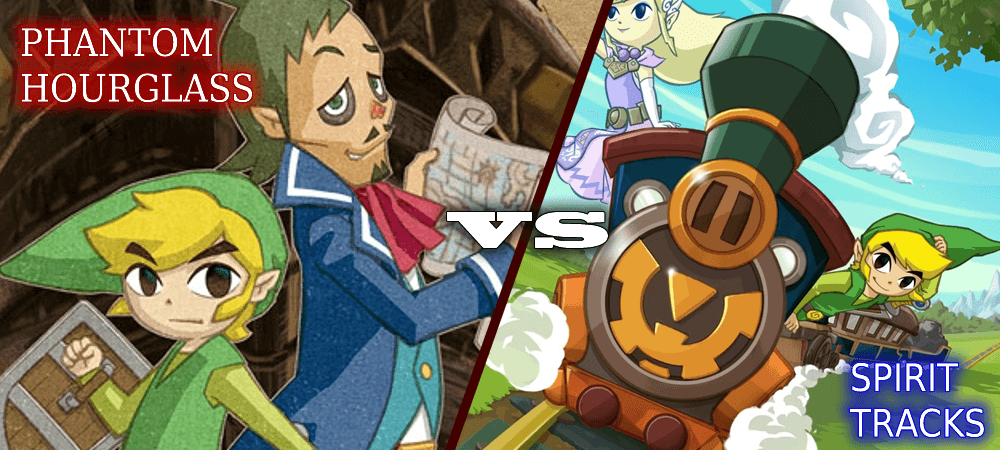Table of Contents
A Tale of Two Screens: Zelda on DS and 3DS

Determining the best Zelda DS game is an easier feat than it may seem. The Nintendo DS and 3DS gave Zelda fans a surprising range of adventures—six official titles spanning ports, remakes, sequels, and one brand-new timeline entry. Across these two systems, the lineup included:
- Phantom Hourglass (2007) – DS exclusive
- Spirit Tracks (2009) – DS exclusive
- Ocarina of Time 3D (2011) – 3DS remake
- A Link Between Worlds (2013) – 3DS exclusive sequel to A Link to the Past
- Majora’s Mask 3D (2015) – 3DS remake
- Tri Force Heroes (2015) – 3DS multiplayer-focused spin-off
Among these six games, only two were built entirely from the ground up for the Nintendo DS: Phantom Hourglass and Spirit Tracks. While the 3DS offered refinements of N64-era masterpieces and a few bold new experiments, the DS was where Nintendo truly leaned into hardware-specific innovation. These two titles weren’t just entries in the Zelda timeline—they were testbeds for stylus-based controls, microphone puzzles, and new ways to experience Hyrule on a portable screen.
And though the 3DS titles often steal the spotlight in retrospective rankings—thanks to the legacy of Ocarina or the inventive brilliance of A Link Between Worlds—it’s Phantom Hourglass and Spirit Tracks that embody the spirit of experimentation that defined Zelda’s DS era.
This article doesn’t aim to pit all six handheld Zelda games against one another. Instead, we’re zooming in on the platform-exclusive DS entries in making the determination of the best Zelda DS release, the only ones that can truly be considered native to the dual-screen system. The question is simple: Between Phantom Hourglass and Spirit Tracks, which is the best DS Zelda?
Let’s set sail—and maybe lay some tracks—on the road to that answer.
Best Zelda DS Contender #1: Phantom Hourglass – A Nautical Adventure

Right out of the gate, Phantom Hourglass did what few Zelda games had dared—it asked you to forget buttons. Movement, swordplay, map annotations, and item usage were all handled via the stylus. The gamble paid off.
It was a direct continuation of The Wind Waker, giving us more Tetra, more Toon Link, and more seafaring exploration—albeit scaled down for handheld play. It wasn’t just nostalgia bait, either: the Ocean King’s Temple introduced a pseudo-roguelike progression system long before the genre surged in popularity. The Phantom guards were menacing, the time mechanic added pressure, and the sense of returning stronger with new tools nailed that core Zelda loop.
Fans praised its clever dungeon design, satisfying puzzles, and the way it turned the DS hardware into a game mechanic. Scribbling notes on maps felt essential, not gimmicky. And how could we forget the treasure maps, salvage crane mini-games, and customizable ship parts?
Commercially, Phantom Hourglass was a success, selling approximately 4.76 million copies worldwide. Its critical acclaim and strong sales underscore its impact on the Zelda franchise and handheld gaming. Could this title be the best Zelda DS game?
Hardcore takeaway: Phantom Hourglass succeeded because it respected the puzzle-first philosophy of classic Zelda while rethinking how to interact with the world.
Quick Links: Buy it on Amazon. View it on Nintendo’s Official Web SIte.
Best Zelda DS Contender #2: Spirit Tracks – On the Rails

Two years later, Spirit Tracks barreled onto the scene—literally. Ditching open seas for a train on fixed rails, this game introduced Hyrule’s first major transportation grid. It expanded on its predecessor in several ways: the dungeons were meatier, Zelda herself was finally a true companion, and controlling Phantoms in tandem with Link opened the door for some of the series’ most interesting dual-character puzzles.
But here’s where it divides the fanbase:
The overworld was no longer open—it was a railroad, both literally and figuratively. Exploration was reduced to station-hopping. Need to backtrack? You’re doing it in real time at 20 mph. Some players felt the Spirit Flute’s reliance on microphone input took novelty too far—great when it worked, annoying when it didn’t.
Still, Spirit Tracks dared to push the Zelda formula. It just asked you to accept a few clunky concessions along the way.
In terms of sales, Spirit Tracks sold approximately 2.96 million copies worldwide. While respectable, it fell short of its predecessor’s commercial performance. Could the best Zelda DS title have such low sales volume?
Hardcore takeaway: It was bold, but it occasionally let its big ideas get in the way of fluid gameplay.
Quick Links: Buy it Amazon. View it on Nintendo’s Official Web Site.
Community and Critical Reception

The gaming community has often debated the merits of these two titles. In various forums and discussions, players have highlighted Phantom Hourglass for its better pacing, more engaging exploration, and superior use of the DS’s features. Conversely, while Spirit Tracks was acknowledged for its improved dungeon design, the overall consensus leaned towards Phantom Hourglass as the more enjoyable experience.
Honorable Mention: Four Swords Adventures (DSiWare version)

While not a traditional DS game, we’d be remiss not to shout out Four Swords Anniversary Edition (available briefly via DSiWare). If you managed to grab it before it vanished, you know how much chaotic fun local co-op Zelda can be.
Conclusion

Both Phantom Hourglass and Spirit Tracks brought fresh ideas to the Zelda series on the DS, each with its own strengths and innovations. However, considering the intuitive controls, engaging exploration, and overall reception, Phantom Hourglass stands out as the best Zelda game on the Nintendo DS. Its successful integration of the DS’s unique features and its continuation of the beloved Wind Waker storyline make it a must-play for fans of the series.






